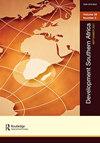From zero-base budgeting to spending review – achievements and challenges
IF 1.3
4区 经济学
Q3 DEVELOPMENT STUDIES
引用次数: 0
Abstract
ABSTRACTThis paper traces the development of spending reviews from their origins in a set of budgetary innovations in the United States in the 1950s and 1960s – notably zero-base budgeting (ZBB) and Planning, Programming and Budgeting Systems (PPBS) – to their application internationally for budget management and fiscal consolidation. Spending reviews have been successfully developed and applied in mostly advanced economies but, because they rely on advanced tools of fiscal analysis and established public financial management systems, their application in low- and middle-income countries is more limited. Many countries use spending reviews to identify budgetary savings or to improve the efficiency and effectiveness of the government's spending policies and programmes. The reviews can either be comprehensive or target specific programmes or areas of spending. Finance ministries are the cornerstone of an effective spending review process, which requires strong analytical skills and tools, as well as reliable data. Line ministries also play a key role and good use can be made of external experts. Political oversight and good governance are fundamental to success, but countries have followed a variety of models in designing their spending review processes; simpler approaches are available for countries with low capacity.KEYWORDS: Spending reviewszero-based budgetingbudgetary savingsefficiencyeffectivenessfinance ministries analytical tools and skills AcknowledgementThis article draws on material presented at a workshop on ZBB organized by the South African National Treasury in January 2021. The authors would like to give thanks to the organizers of that workshop, to Julien Dubertret, Gerhard Steger and Sami Ylaoutinen for their presentations, and to the two anonymous referees for their helpful comments on an earlier version of the article.Disclaimer StatementThe views expressed in this paper are those of the author(s) and do not necessarily represent the views of the IMF, its Executive Board, or IMF management.Disclosure statementNo potential conflict of interest was reported by the author(s).Notes1 Applied to the public sector, allocative efficiency means the mix of public goods and services delivered by the government that represents the combination that is most desired by society. Productive efficiency means that, given the available resources and technology, it is not possible to increase the output of any public service (e.g., education or health) without decreasing the output of another service.2 For further information on the concept of ‘baseline expenditures’ and a methodology for estimating baselines over the medium term, see Rahim and Wendling, Citation2022.3 See, for example, https://thedocs.worldbank.org/en/doc/274711479159288956-0290022017/originial/GuidanceNoteonValueforMoney.pdf4 This section draws on a helpful paper on the history of ZBB by the South Africa National Treasury (Citation2020).5 Texas Instruments Incorporated is an American technology company headquartered in Dallas, Texas, that designs and manufactures semiconductors and various information technology equipment.6 A nonprofit, nonpartisan research organization that helps improve policy and decision making through research and analysis.7 Technically a Constitutional Bylaw on Budget Acts (la loi organique de 2001 relative aux loi des finances, widely referred to as the LOLF).8 The United Kingdom and Australia are examples of countries that produce multiyear baseline projections (see Rahim and Wendling, Citation2022).9 Each year since 2017 a detailed analysis of compensation trends based on spending review methodologies has been included in the South African Medium-term Budget Policy Statement.10 The OECD are preparing a new survey of spending reviews, based on more recent data, but the consolidated results have not yet been published.11 National Treasury spending review methodology. This involves six stages: policy and institutional analysis, logical analysis, performance indicator analysis, expenditure analysis, cost modelling, and report and action planning.12 As a consequence of the COVID-19 pandemic, the 2020 review covered just a one-year period in contrast to the usual multi-annual framework.13 For example, see H.M. Treasury, Autumn Budget and Spending Review 2021, and Autumn Statement 2022.从零基预算到支出审查——成就与挑战
摘要本文追溯了支出审查的发展,从20世纪50年代和60年代美国的一系列预算创新——特别是零基础预算(ZBB)和计划、规划和预算系统(PPBS)——到它们在预算管理和财政整顿中的国际应用。支出审查已在大多数发达经济体成功地发展和应用,但由于它们依赖于先进的财政分析工具和已建立的公共财政管理系统,因此在低收入和中等收入国家的应用较为有限。许多国家利用支出审查来确定预算节余或提高政府支出政策和方案的效率和效力。审查可以是全面的,也可以针对具体的方案或支出领域。财政部是有效支出审查程序的基石,这需要强大的分析能力和工具,以及可靠的数据。各部门也发挥关键作用,外部专家也能得到很好的利用。政治监督和良好治理是成功的基础,但各国在设计支出审查程序时遵循了各种模式;能力较低的国家可采用更简单的方法。关键词:支出审查、零基预算、预算节约效率、财政部分析工具和技能确认本文借鉴了南非国家财政部于2021年1月组织的ZBB研讨会上提交的材料。作者要感谢研讨会的组织者,感谢Julien Dubertret, Gerhard Steger和Sami Ylaoutinen的介绍,以及两位匿名审稿人对文章早期版本的有益评论。免责声明本文所表达的观点仅代表作者的观点,并不一定代表基金组织、其执董会或基金组织管理层的观点。披露声明作者未报告潜在的利益冲突。注1对于公共部门,配置效率是指政府提供的公共产品和服务的组合,代表了社会最期望的组合。1 .生产效率意味着,在现有资源和技术的情况下,不可能在不减少另一种服务产出的情况下增加任何公共服务(如教育或卫生)的产出有关“基线支出”概念和中期基线估算方法的进一步信息,请参见Rahim和Wendling, Citation2022.3参见,例如,https://thedocs.worldbank.org/en/doc/274711479159288956-0290022017/originial/GuidanceNoteonValueforMoney.pdf4本节借鉴了南非国家财政部关于ZBB历史的有益论文(Citation2020)德州仪器公司是一家总部位于美国德克萨斯州达拉斯市的科技公司,主要从事半导体和各种信息技术设备的设计和制造一个非营利性、无党派的研究组织,通过研究和分析帮助改进政策和决策制定7 .从技术上讲,这是一部关于预算法的宪法章程(2001年关于财政的组织法,通常被称为《预算章程》)联合王国和澳大利亚是产生多年基线预测的国家的例子(见Rahim和Wendling, Citation2022)自2017年以来,《南非中期预算政策声明》每年都将基于支出审查方法对薪酬趋势进行详细分析。经合组织正在根据最新数据编制一项新的支出审查调查,但综合结果尚未公布国库支出审查方法。这包括六个阶段:政策和制度分析、逻辑分析、绩效指标分析、支出分析、成本建模以及报告和行动计划由于2019冠状病毒病大流行,与通常的多年度框架相比,2020年审查仅涵盖一年例如,参见H.M.财政部,2021年秋季预算和支出审查,以及2022年秋季报表。
本文章由计算机程序翻译,如有差异,请以英文原文为准。
求助全文
约1分钟内获得全文
求助全文
来源期刊

Development Southern Africa
DEVELOPMENT STUDIES-
CiteScore
4.20
自引率
7.10%
发文量
42
期刊介绍:
The Development Southern Africa editorial team are pleased to announce that the journal has been accepted into the Thomson Reuters (formerly ISI) Social Science Citation Index. The journal will receive its first Impact Factor in 2010. Development Southern Africa offers a platform for expressing views and encouraging debate among development specialists, policy decision makers, scholars and students in the wider professional fraternity and especially in southern Africa. The journal publishes articles that reflect innovative thinking on key development challenges and policy issues facing South Africa and other countries in the southern African region.
 求助内容:
求助内容: 应助结果提醒方式:
应助结果提醒方式:


